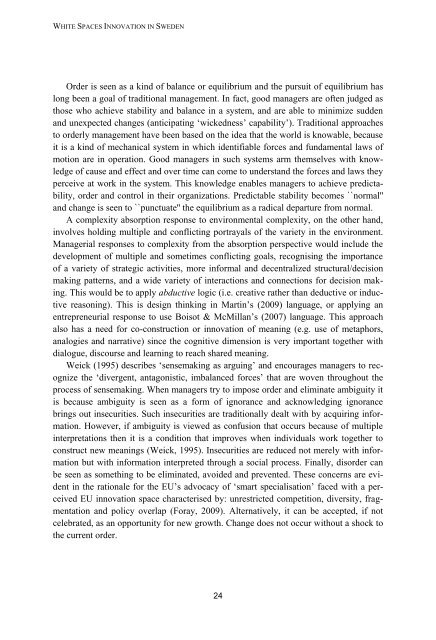White Spaces Innovation in Sweden - Innovation policy for ... - Vinnova
White Spaces Innovation in Sweden - Innovation policy for ... - Vinnova
White Spaces Innovation in Sweden - Innovation policy for ... - Vinnova
Create successful ePaper yourself
Turn your PDF publications into a flip-book with our unique Google optimized e-Paper software.
WHITE SPACES INNOVATION IN SWEDENOrder is seen as a k<strong>in</strong>d of balance or equilibrium and the pursuit of equilibrium haslong been a goal of traditional management. In fact, good managers are often judged asthose who achieve stability and balance <strong>in</strong> a system, and are able to m<strong>in</strong>imize suddenand unexpected changes (anticipat<strong>in</strong>g „wickedness‟ capability‟). Traditional approachesto orderly management have been based on the idea that the world is knowable, becauseit is a k<strong>in</strong>d of mechanical system <strong>in</strong> which identifiable <strong>for</strong>ces and fundamental laws ofmotion are <strong>in</strong> operation. Good managers <strong>in</strong> such systems arm themselves with knowledgeof cause and effect and over time can come to understand the <strong>for</strong>ces and laws theyperceive at work <strong>in</strong> the system. This knowledge enables managers to achieve predictability,order and control <strong>in</strong> their organizations. Predictable stability becomes ``normal''and change is seen to ``punctuate'' the equilibrium as a radical departure from normal.A complexity absorption response to environmental complexity, on the other hand,<strong>in</strong>volves hold<strong>in</strong>g multiple and conflict<strong>in</strong>g portrayals of the variety <strong>in</strong> the environment.Managerial responses to complexity from the absorption perspective would <strong>in</strong>clude thedevelopment of multiple and sometimes conflict<strong>in</strong>g goals, recognis<strong>in</strong>g the importanceof a variety of strategic activities, more <strong>in</strong><strong>for</strong>mal and decentralized structural/decisionmak<strong>in</strong>g patterns, and a wide variety of <strong>in</strong>teractions and connections <strong>for</strong> decision mak<strong>in</strong>g.This would be to apply abductive logic (i.e. creative rather than deductive or <strong>in</strong>ductivereason<strong>in</strong>g). This is design th<strong>in</strong>k<strong>in</strong>g <strong>in</strong> Mart<strong>in</strong>‟s (2009) language, or apply<strong>in</strong>g anentrepreneurial response to use Boisot & McMillan‟s (2007) language. This approachalso has a need <strong>for</strong> co-construction or <strong>in</strong>novation of mean<strong>in</strong>g (e.g. use of metaphors,analogies and narrative) s<strong>in</strong>ce the cognitive dimension is very important together withdialogue, discourse and learn<strong>in</strong>g to reach shared mean<strong>in</strong>g.Weick (1995) describes „sensemak<strong>in</strong>g as argu<strong>in</strong>g‟ and encourages managers to recognizethe „divergent, antagonistic, imbalanced <strong>for</strong>ces‟ that are woven throughout theprocess of sensemak<strong>in</strong>g. When managers try to impose order and elim<strong>in</strong>ate ambiguity itis because ambiguity is seen as a <strong>for</strong>m of ignorance and acknowledg<strong>in</strong>g ignorancebr<strong>in</strong>gs out <strong>in</strong>securities. Such <strong>in</strong>securities are traditionally dealt with by acquir<strong>in</strong>g <strong>in</strong><strong>for</strong>mation.However, if ambiguity is viewed as confusion that occurs because of multiple<strong>in</strong>terpretations then it is a condition that improves when <strong>in</strong>dividuals work together toconstruct new mean<strong>in</strong>gs (Weick, 1995). Insecurities are reduced not merely with <strong>in</strong><strong>for</strong>mationbut with <strong>in</strong><strong>for</strong>mation <strong>in</strong>terpreted through a social process. F<strong>in</strong>ally, disorder canbe seen as someth<strong>in</strong>g to be elim<strong>in</strong>ated, avoided and prevented. These concerns are evident<strong>in</strong> the rationale <strong>for</strong> the EU‟s advocacy of „smart specialisation‟ faced with a perceivedEU <strong>in</strong>novation space characterised by: unrestricted competition, diversity, fragmentationand <strong>policy</strong> overlap (Foray, 2009). Alternatively, it can be accepted, if notcelebrated, as an opportunity <strong>for</strong> new growth. Change does not occur without a shock tothe current order.24
















